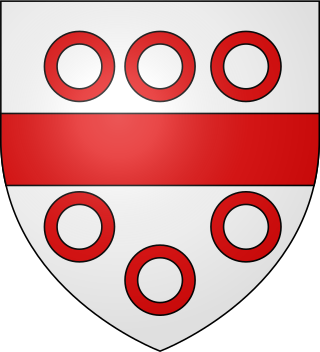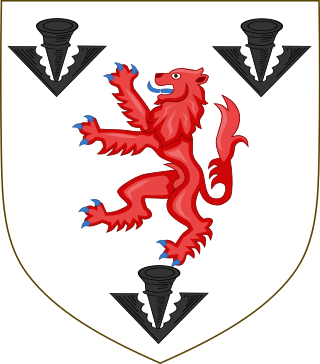
Baron Grey de Wilton is a title that has been created twice, once in the Peerage of England (1295) and once in the Peerage of Great Britain (1784). The first creation was forfeit and the second creation is extinct.

Baron Grey de Wilton is a title that has been created twice, once in the Peerage of England (1295) and once in the Peerage of Great Britain (1784). The first creation was forfeit and the second creation is extinct.
The first creation was generally dated to 23 June 1295, when Reginald de Grey was summoned to an assembly prior to the Model Parliament that was summoned that November, as Lord Grey de Wilton. Burke's Peerage [1] notes that the June "assembly in question is not now recognized as a bona fide Parl[iament]", but that Reginald had earlier been summoned to the "assembly called a full Parl[iament] of 29 May 1290". This branch of the Grey family of aristocrats was based at Wilton Castle on the Welsh border in Herefordshire. The Greys of Wilton, as well as the other old noble families bearing the name of Grey/Gray, are descended from the Norman knight Anchetil de Greye. Wilton Castle itself passed from the family when the 13th baron was forced to sell it to raise his ransom after being captured in France. Sir Thomas Grey, the 15th baron, was attainted in 1603, forfeiting his titles and honours, after being convicted of treason for his alleged involvement in the Bye Plot against King James I. Grey never married. The attainder against him was not reversed prior to his death. His two sisters would have been his co-heiresses but for the attainder; one of them, Bridget, married Sir Roland Egerton, 1st Baronet, and they were ancestors of the recipient of the second creation below. [2]

The second creation was in 1784, when Sir Thomas Egerton (1749–1814) was created Baron Grey de Wilton, of Wilton Castle, with remainder to the heirs male of his body. He was a member of the Egerton family and had in 1756 succeeded to his father's Grey Egerton baronetcy. The 1st baronet had married Bridget Grey, the sister of Sir Thomas Grey. In 1801, the 1st Baron Grey de Wilton was also made Viscount Grey de Wilton and Earl of Wilton , of Wilton Castle in the County of Hereford, in the Peerage of the United Kingdom. The latter titles were created with remainder to the second and younger sons successively of his daughter Eleanor, wife of Robert Grosvenor, 1st Marquess of Westminster.
On the first earl of Wilton's death in 1804, the Grey de Wilton barony became extinct, as he had no sons, while the Grey Egerton baronetcy passed to a distant relative. The titles of Earl of Wilton and Viscount Grey de Wilton passed, according to the special remainder, to the 1st earl's grandson, Thomas Grosvenor (1799–1882), who adopted the surname of Egerton and became the 2nd earl. These titles are still extant.
| Grosvenor and Grey family tree: Dukes of Westminster, Marquesses of Westminster Earls: Grosvenor, Sussex (5th creation), and of Wilton Viscounts: Belgrave, Grey de Wilton, and de Longueville and Barons: Grey de Wilton, Grey of Ruthin (Ruthyn), Grey de Radcliffe, Ebury, Grosvenor, and Stalbridge | |||||||||||||||||||||||||||||||||||||||||||||||||||||||||||||||||||||||||||||||||||||||||||||||||||||||||||||||||||||||||||||||||||||||||||||||||||||||||||||||||||||||||||||||||||||||||||||||||||||||||||||||||||||||||||||||||||||||||||||||||||||||||||||||||||||||||||||||||||||||||||||||||||||||||||||||||||||||||||||||||||||||||||||||||||||||||||||||||||||||||||||||||||||||||||||||||||||||||||||||||||||||||||||||||||||||||||||||||||||||||||||||||||||||||||||||||||||||||||||||||||||||||||||||||||||||||||||||||||||||||||||||||||||||||||||||||||||||||||||||||||||||||||||||||||||||||||||||||||||||||||||||||||||||||||||||||||||||||||||||||||||||||||||||||||||||||||||||||||||||||||||||||||||||||||||||||||||||||||||||||||||||||||||||||||||||||||||||||||||||||||||||||||||||||||||||||||||||||||||||||||||||||||||||||||||||||||||||||||||||||||||||||||||||||||||||||||||||||||||||||||||||||||||||||||||||||||||||||||||||||||||||||||||||||||||||||||||||||||||||||||||||||||||||||||||||||||||||||||||||
|---|---|---|---|---|---|---|---|---|---|---|---|---|---|---|---|---|---|---|---|---|---|---|---|---|---|---|---|---|---|---|---|---|---|---|---|---|---|---|---|---|---|---|---|---|---|---|---|---|---|---|---|---|---|---|---|---|---|---|---|---|---|---|---|---|---|---|---|---|---|---|---|---|---|---|---|---|---|---|---|---|---|---|---|---|---|---|---|---|---|---|---|---|---|---|---|---|---|---|---|---|---|---|---|---|---|---|---|---|---|---|---|---|---|---|---|---|---|---|---|---|---|---|---|---|---|---|---|---|---|---|---|---|---|---|---|---|---|---|---|---|---|---|---|---|---|---|---|---|---|---|---|---|---|---|---|---|---|---|---|---|---|---|---|---|---|---|---|---|---|---|---|---|---|---|---|---|---|---|---|---|---|---|---|---|---|---|---|---|---|---|---|---|---|---|---|---|---|---|---|---|---|---|---|---|---|---|---|---|---|---|---|---|---|---|---|---|---|---|---|---|---|---|---|---|---|---|---|---|---|---|---|---|---|---|---|---|---|---|---|---|---|---|---|---|---|---|---|---|---|---|---|---|---|---|---|---|---|---|---|---|---|---|---|---|---|---|---|---|---|---|---|---|---|---|---|---|---|---|---|---|---|---|---|---|---|---|---|---|---|---|---|---|---|---|---|---|---|---|---|---|---|---|---|---|---|---|---|---|---|---|---|---|---|---|---|---|---|---|---|---|---|---|---|---|---|---|---|---|---|---|---|---|---|---|---|---|---|---|---|---|---|---|---|---|---|---|---|---|---|---|---|---|---|---|---|---|---|---|---|---|---|---|---|---|---|---|---|---|---|---|---|---|---|---|---|---|---|---|---|---|---|---|---|---|---|---|---|---|---|---|---|---|---|---|---|---|---|---|---|---|---|---|---|---|---|---|---|---|---|---|---|---|---|---|---|---|---|---|---|---|---|---|---|---|---|---|---|---|---|---|---|---|---|---|---|---|---|---|---|---|---|---|---|---|---|---|---|---|---|---|---|---|---|---|---|---|---|---|---|---|---|---|---|---|---|---|---|---|---|---|---|---|---|---|---|---|---|---|---|---|---|---|---|---|---|---|---|---|---|---|---|---|---|---|---|---|---|---|---|---|---|---|---|---|---|---|---|---|---|---|---|---|---|---|---|---|---|---|---|---|---|---|---|---|---|---|---|---|---|---|---|---|---|---|---|---|---|---|---|---|---|---|---|---|---|---|---|---|---|---|---|---|---|---|---|---|---|---|---|---|---|---|---|---|---|---|---|---|---|---|---|---|---|---|---|---|---|---|---|---|---|---|---|---|---|---|---|---|---|---|---|---|---|---|---|---|---|---|---|---|---|---|---|---|---|---|---|---|---|---|---|---|---|---|---|---|---|---|---|---|---|---|---|---|---|---|---|---|---|---|---|---|---|---|---|---|---|---|---|---|---|---|---|---|---|---|---|---|---|---|---|---|---|---|---|---|---|---|---|---|---|---|---|---|---|---|---|---|---|---|---|---|---|---|---|---|---|---|---|---|---|---|---|---|---|---|---|---|---|---|---|---|---|---|---|---|---|---|---|---|---|---|---|---|---|---|---|---|---|---|---|---|---|---|---|---|---|---|---|---|---|---|---|---|---|---|---|---|---|---|---|---|---|---|---|---|---|---|---|---|---|---|---|---|---|---|---|---|---|---|---|---|---|---|---|---|---|---|---|---|---|---|---|---|---|---|---|---|---|---|---|---|---|---|---|---|---|---|---|---|---|---|---|---|---|---|---|---|---|---|---|---|---|---|---|---|---|---|---|---|---|---|---|---|---|---|---|---|---|---|---|---|---|---|---|---|---|---|---|---|---|---|---|---|---|---|---|---|---|---|---|---|---|---|---|---|---|---|---|---|---|---|---|---|---|---|---|---|---|---|---|---|---|---|---|---|---|---|---|---|---|---|---|---|---|---|---|---|---|---|---|---|---|---|---|---|---|---|---|---|---|---|---|---|---|---|---|---|---|---|---|---|---|---|---|---|---|---|---|---|---|---|---|---|---|---|---|---|---|---|---|---|---|---|---|---|---|---|---|---|---|---|---|---|---|---|---|---|---|---|---|---|---|---|---|---|---|---|---|---|---|---|---|---|---|---|---|---|---|---|---|---|---|---|---|---|---|---|---|---|---|---|---|---|---|---|---|---|---|---|---|---|---|---|---|---|---|---|---|---|---|---|---|---|---|---|---|---|---|---|---|---|---|---|---|---|---|---|---|
| |||||||||||||||||||||||||||||||||||||||||||||||||||||||||||||||||||||||||||||||||||||||||||||||||||||||||||||||||||||||||||||||||||||||||||||||||||||||||||||||||||||||||||||||||||||||||||||||||||||||||||||||||||||||||||||||||||||||||||||||||||||||||||||||||||||||||||||||||||||||||||||||||||||||||||||||||||||||||||||||||||||||||||||||||||||||||||||||||||||||||||||||||||||||||||||||||||||||||||||||||||||||||||||||||||||||||||||||||||||||||||||||||||||||||||||||||||||||||||||||||||||||||||||||||||||||||||||||||||||||||||||||||||||||||||||||||||||||||||||||||||||||||||||||||||||||||||||||||||||||||||||||||||||||||||||||||||||||||||||||||||||||||||||||||||||||||||||||||||||||||||||||||||||||||||||||||||||||||||||||||||||||||||||||||||||||||||||||||||||||||||||||||||||||||||||||||||||||||||||||||||||||||||||||||||||||||||||||||||||||||||||||||||||||||||||||||||||||||||||||||||||||||||||||||||||||||||||||||||||||||||||||||||||||||||||||||||||||||||||||||||||||||||||||||||||||||||||||||||||||

Earl of Devon is a title that has been created several times in the Peerage of England. It was possessed first by the Redvers family, and later by the Courtenay family. It is not to be confused with the title of Earl of Devonshire, which is held by the Duke of Devonshire, although the letters patent for the creation of the latter peerages used the same Latin words, Comes Devon(iae). It was a re-invention, if not an actual continuation, of the pre-Conquest office of Ealdorman of Devon.

Baron Hastings is a title that has been created three times. The first creation was in the Peerage of England in 1290, and is extant. The second creation was in the Peerage of England in 1299, and became extinct on the death of the first holder in c. 1314. The third creation was in the Peerage of England in 1461, and has been in abeyance since 1960.

Baron Lucas is a title that has been created twice in the Peerage of England. The second creation is extant and is currently held with the title Lord Dingwall in the Peerage of Scotland.

Baron Stafford, referring to the town of Stafford, is a title that has been created several times in the Peerage of England. In the 14th century, the barons of the first creation were made earls. Those of the fifth creation, in the 17th century, became first viscounts and then earls. Since 1913, the title has been held by the Fitzherbert family.

Baron le Despencer is a title that has been created several times by writ in the Peerage of England.

Earl of Wilton, of Wilton Castle in the County of Herefordshire, is a title in the Peerage of the United Kingdom. It was created in 1801 for Thomas Egerton, 1st Baron Grey de Wilton, along with the subsidiary title of Viscount Grey de Wilton, also in the Peerage of the United Kingdom. Both titles were created with remainder to the second and all younger sons successively of his daughter Eleanor, wife of Robert Grosvenor, 1st Marquess of Westminster.

Earl of Strafford is a title that has been created three times in English and British history.
Lord Dingwall is a title in the Peerage of Scotland. It was created in 1584 for Andrew Keith, and in 1609 for Sir Richard Preston, with remainder to his heirs whatsoever. In 1619 he was further honoured when he was made Baron Dunmore and Earl of Desmond in the Peerage of Ireland, with remainder to heirs male. On his death in 1628 the Irish titles became extinct while he was succeeded in the Scottish lordship by his daughter Elizabeth, the second Lady Dingwall. She was the wife of James Butler, 1st Duke of Ormonde. Their eldest son Thomas Butler, Earl of Ossory, was summoned by writ to the English Parliament as Baron Butler, of Moore Park, in 1666. However, he predeceased his parents who were both succeeded by their grandson, the second Duke and third Lord Dingwall. He had already succeeded his father as second Baron Butler. However, the Duke was attainted in 1715 and his titles forfeited. In 1871, Francis Cowper, 7th Earl Cowper, managed to obtain a reversal of the attainder of the lordship of Dingwall and barony of Butler and became the fourth Lord Dingwall and third Baron Butler. He was the great-great-great-grandson of Henrietta d'Auverquerque, Countess of Grantham, second daughter of Thomas Butler, Earl of Ossory and 1st Baron Butler, whose second daughter Lady Henrietta de Nassau d'Auverquerque married William Clavering-Cowper, 2nd Earl Cowper. In 1880 he also succeeded his mother as eighth Baron Lucas of Crudwell. For later history of the lordship of Dingwall and barony of Butler, see the Baron Lucas of Crudwell.

The Dukedom of Chandos was a title in the Peerage of Great Britain. The Chandos peerage was first created as a barony by Edward III in 1337; its second creation in 1554 was due to the Brydges family's service to Mary I during Wyatt's rebellion, when she also gave them Sudeley Castle. The 9th Baron of the second creation was elevated to the dukedom in 1719, but after his grandson's death without male heirs, his titles all became extinct.
The title of Baron Welles has been created three times. Its first creation was for Adam de Welles on 6 May 1299 in the Peerage of England by writ of summons. This creation was extinguished by attainder in 1469. The title was created a second time in the Peerage of England by writ of summons for Sir Richard Hastings on 15 November 1482 and became extinct on his death. The third creation was on 8 January 1781, in the Peerage of Ireland, for Thomas Knox, later Viscount Northland. It is now a subsidiary title of the Earl of Ranfurly.

Hugh le Despenser, 1st Baron le Despenser, Lord of Glamorgan, was an English peer. Imprisoned as a consequence of his support for deposed king Edward II, he would return to royal favour under Edward III, being made Baron le Despenser in 1338. His title became extinct at his death without issue.

Baron Ebury, of Ebury Manor in the County of Middlesex, is a title in the Peerage of the United Kingdom that dates from 1857. In 1999, it became a subsidiary title of the earldom of Wilton after the 6th Baron Ebury inherited the earldom from his distant cousin, the 7th Earl of Wilton.

The titles Baron Montacute or Baron Montagu were created several times in the Peerage of England for members of the House of Montagu. The family name was Latinised to de Monte Acuto, meaning "from the sharp mountain"; the French form is an ancient spelling of mont aigu, with identical meaning.
The Egerton, laterGrey Egerton, later stillEgerton baronetcy, of Egerton and Oulton in the county of Chester, is a title in the Baronetage of England held by the senior patrilineal branch of the Egerton family.

Thomas Grey Egerton, 1st Earl of Wilton, known as Sir Thomas Grey Egerton, Bt from 1766 to 1784, was a British politician who sat in the House of Commons from 1772 to 1784 when he was raised to the peerage as Baron Grey de Wilton.
Richard Grey, 3rd Earl of Tankerville, 8th Lord of Powys fought on the side of the House of York in the War of the Roses.
Baron Astley (1295) was created by writ of summons dated 23 June 1295 for a family which had lived at Astley, Warwickshire, England since the time of Henry I. Sir Thomas de Astley who was killed in the Battle of Evesham in 1265 married twice. From Sir Thomas's first marriage to Joan de Blois descended the Barons Astley.

The Egerton family is a British aristocratic family. Over time, several members of the Egerton family were made Dukes, Earls, knights, baronets and peers. Hereditary titles held by the Egerton family include the dukedoms of Bridgewater (1720–1803) and Sutherland, as well as the earldoms of Bridgewater (1617–1829), Wilton (1801–1999) and Egerton (1897–1909). Several other members of the family have also risen to prominence. The Egerton family motto is Virtuti non armis fido.

The Grey family is an ancient English noble family from Creully in Normandy. The founder of the family was Anchetil de Greye, a Norman chevalier and vassal of William FitzOsbern, 1st Earl of Hereford, one of the few proven companions of William the Conqueror known to have fought at the Battle of Hastings in 1066.

The title Baron Cobham has been created numerous times in the Peerage of England; often multiple creations have been extant simultaneously, especially in the fourteenth century.